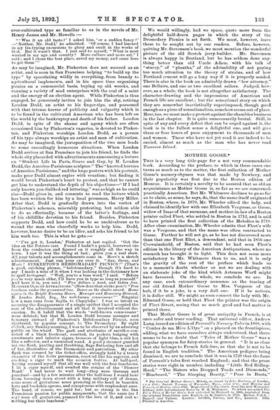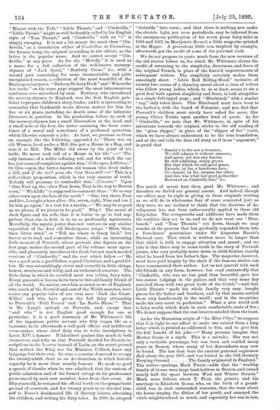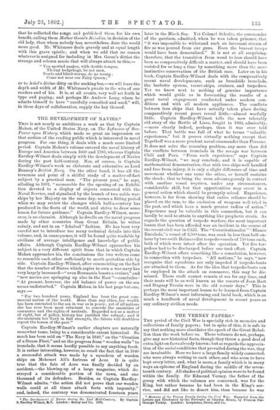MOTHER GOOSE.*
THIS is a very long title-page for a not very commendable book. According to the preface, to which in these cases one turns as much as to the matter, the first collection of Mother Goose's nursery-rhymes was that made by Newbery, and their popularity was first due to the Boston edition of Munroe. It is certainly a novelty to be assured that so old an acquaintance as Mother Goose is, so far as we are concerned, practically American. But Mr. Whitmore declines to go so far as to claim, as some, he says, do, that the name itself originated in Boston, where, in 1870, Mr. Wheeler edited the lady, and claimed to identify her with one Elizabeth Vergoose, or Goose, widow of Isaac of that surname, and mother-in-law of a Boston printer called Fleet, who settled in Boston in 1712, and is said to have printed the first collection of the Melodies in 1719. After close examination, Mr. Wheeler admits that Fleet's wife was a Vergoose, and that the name was often contracted to Goose. Further be will not go, as he has not discovered more than that one Fleet Eliot, a descendant, said that in 1856 one Crowninshield, of Boston, said that he had seen Fleet's edition in the library of the American Antiquarians, where no research has brought it to light. This does not seem more satisfactory to Mr. Whitmore than to us, and it is only the gravity of the rest of the preface which leads us to a moment's doubt whether or not we are dealing with an elaborate joke of the kind which Artemus Wart might have favoured. On the whole, we conclude we are. In any case, such extraordinary nonsense as the tracing of our old friend Mother Goose to Mrs. Vergoose of the hub, if it be a joke, is a very dull one. If it be serious, it is duller still. We might as soon connect the lady with Mr. Edmund Gosse, or hold that Fleet the printer was the origin of Fleet Street, seeing that so much good and bad matter is printed there.
That Mother Goose is of great antiquity in French, is at once safer and truer reading. That universal editor, Andrew Lang, issued an edition of Perrault's Nursery-Tales in 1888, with " Contes de ma Mere L'Oye " on a placard on the frontispiece, adding, what we have ourselves always understood, that there seems to be no doubt that " Tales of Mother Goose " was a popular synonym for fairy-stories in general. " It is as clear that she belongs to French folk-lore, as that she is not to be found in English tradition." The American pedigree being dismissed, we are to conclude that it was in 1729 that the fame of Perrault's tales first reached England ; and that the prose stories were eight in number, including "Little Red Riding. Hood," "The Sisters who Dropped Toads and Diamonds," " Bluebeard," " The Sleeping Beauty," " Pass in Boots,"
• The Orig,nal Mother Goose's Melody, as issued by John Newbery, of London, c:r.a 1760; Isaiah Tsomas, of Worcester, Mass., circa 1736; and Munroe and Francis, of Boston, circa 1F55. Reprodnced in Facsimile from the first Worcester Edition, with Introductory Notes by W. H. Whitmore. To which are added The Fairy Tales of Mo'her Goo.e, first collected by Perrault in 1898, reprinted from the original 'Translation into English, by R. Samber, in 171. Boston, U.S.A. : Damreli and Upham. London Griffith, Ferran, and Co., Limited. 1892. Printed in America. " Riquet with the Tuft," "Little Thumb," and "Cinderilla." " Little Thumb " might as well be frankly called by his English style of "Tom Thumb," and " Cinderilla " with an " i " is simply enraging. It is not a bit nearer the mark than " Cin- derella," as a translation either of Cendrillon or Cucendron, the former being the original (according to the editor), as the latter is the popular name. And we cannot accept " Cin- derilla" at any price. As for the "Melody," it is used as a name for a full collection of the well-known nursery- rhymes of "Jack Sprat," "Banbury Cross," &e., with a second part containing, for some inconceivable and quite unexplained reason, a collection of the most beautiful of the Shakespearian lyrics. " Dickery Dickery Dock " and " Where the bee sucks " on the same page suggest the most inharmonious confusion ever mis-edited by man. Newbery, who introduced the nursery-rhymes to England, was the first English pub- lisher to prepare children's story-books; and it is interesting to remember that Goldsmith wrote diverse matter for him for five or six years, including, no doubt, some of the infantine literature in question. In the production before us, each of the nursery-rhymes has a small illustration at the head, and a small note at the foot, the latter assuming the form some- times of a moral and sometimes of a professed quotation, which likewise conceals a joke. At least, we presume so from an example like the following, appended to " There was an old Woman lived under a Hill, She put a Mouse in a Bag, and sent it to Mill. The Miller did swear by the point of his knife, He never took toll of a Mouse in his life " :—" The only instance of a miller refusing toll, and for which the cat has just cause of complaint against him.' (Coke upon Littleton)." Or this—upon the better-known old woman who lived under a hill, and if she isn't gone, she lives there still :—" ' This is a self-evident proposition, which is the very essense of truth. Nobody will presume to contradict this.' (Crceusa)." Upon " One Foot up, the other Foot down, That is the way to Boston town," " Wickliffe" is supposed to comment thus : "So to any other town upon the face of the earth." " One, two, three, Four and five, I caught a hare alive : Six, seven, eight, Nine and ten, I let him go again," is a text for a maxim,—" We may be as good as we please, if we please to be good." Why ? The moral of Jack Sprat and his wife, that it is better to go to bed sup- perless than rise in debt, is to us as profoundly mysterious. Mercifully, the mystic jester does not venture on any similar exposition of the dear old Shakespeare songs, " Blow, blow, thou bitter wind," or " Tell me where is fancy bred," but leaves us to read and remember them ; while an interesting little memoir of Perrault, whose portrait also figures on the first page, makes the second part of the volume more agree- able, and pleasantly introduces the fresh but not much-needed versions of " Cinderella," and the rest which follow :—" He was a good man, a good father, a good Christian, and a good fel- low. He was astonishingly clever and versatile in little things, honest, oonrteous and witty, and an undaunted amateur. The little thing in which he excelled most was telling fairy tales. Every generation listens in its turn to this old family friend of all the world. No nation owes him so much as we of England, who, south of the Scottish and east of the Welsh marches, have scarce any popular tales of our own, save Jack the Giant- Killer,' and who have given the fall fairy citizenship to Perrault's Petit Poucet ' and La Barbe Bleue.' " That is Mr. Lang's epitaph on Perrault, and, except that " and who " is not English good enough for one so particular, it is a good summary of Mr. Whitmore's life of the ingenious public servant who fitly began life as a barrister, to be afterwards a well-paid official and indifferent verse-maker, whose chief duty was to write inscriptions in Louis XIV.'s honour. D'Alembert praises him much in both characters, and tells us that Perrault decided for French in- scriptions in the Louvre instead of Latin, on the secret ground that neither the King nor his Minister, Colbert, knew any language but their own. So wise a courtier deserved to occupy the twenty-ninth chair as an Academician, in which historic capacity he is more than usually famous. He made so good a speech of thanks when he was admitted, that the custom of public admission and of the formal eulogy on his predecessor pronounced by each new member, dates from that event. At fifty years old, he resigned his official berth on the sympathetic ground of overwork, and for twenty years more devoted him- self to Frere's desiderated life of literary leisure, educating his children, and writing his fairy-tales. In 1690, he adapted
" Griselda " into verse ; and that there is nothing new under the electric light, not even periodicals, may be inferred from the anonymous publication of his seven prose fairy-tales in 1696 and 1697, in Moetjens's Remelt a little magazine printed at the Hague. A precocious little son, inspired by example, afterwards got the credit of some of the paternal work.
We do not propose to quote much from the new versions of the old stories before us, for which Mr. Whitmore claims the credit of returning to the simplicity, directness, and force of the original French, in place of the fancied improvements of subsequent writers. The simplicity certainly makes them amazingly short. " Little Red Riding-Hood," inclusive of twenty-two verses of a rhyming moral about a class of wolves who follow young ladies, which, to us at least, seems to sin a good deal both against simplicity and force, is told altogether in a single full-typed page ; and " Bluebeard," with a similar "tag," only takes three. This Bluebeard must have been to the barber's, with the beard of Polonius ; and you feel that Perrault's children mast surely have asked for more, like young Oliver Twists upon another kind of quest. As for " Cinderilla," we note that Mr. Whitmore, in spite of his intentions towards the original, sticks to the old reading of the " glass slipper," in place of the " slipper of fur" (vair), which we have always understood to be the true translation, and at the end tells the dear old story as if in an "argument," in proof that
" Beauty's to the sex a treasure, We still admire it without measure, And never yet was any known, By still admiring, weary grown. But that which we call good grace, Exceeds, by far, a handsome face; Its charms, by far, surpass the other, And this was what her good godmother Bestowed on Cinderilla fair," &c.
Too much of moral hast thou, good Mr. Whitmore ; and therefore we forbid our general assent. And indeed, though our editor may be right in giving us these originals (writing as we still do in wholesome fear of some concealed jest) as they were, we are inclined to think that the doctrine of de- velopment has not been unfavourably applied to these old fairy-tales. The overgrowths and additions have made them the realities they are to us, and we do not want our " Blue- beards " and " Tom Thumbs " cut down, though we may wonder at the process that has gradually expanded them into a four-hours' pantomime under Sir Augustus Harris's Shrieval care. That which is written must be longer than that which is told, to engage attention and assent ; and we take it that there may be some truth in the story of Perrault junior, who very probably wrote down in child-fashion exactly what he heard from his father's lips. The magazine, however, must have paid largely by the sheet if the famous stories can have remunerated their author. Let us not quarrel with such old friends in any form, however, but read contentedly that " Cinderilla, who was no less good than beautiful, gave her two sisters lodgings in the palace, and that very same day matched them with two great lords of the Court,"—and that Little Thumb "made his whole family very easy, bought places for his father and brothers, and by that means settled them very handsomely in the world ; and in the meantime made his own court to perfection." What a nice world still is fairy-world, which deals in such comfortable coals of fire ; We do not suppose that the coal-bearers minded them the least.
As for the Bostonian origin of " La Mere l'Oye," we suppose that it is right to our editor to make one extract from a long letter which is printed as addressed to him, and to give him the full benefit of his joke :—" Many persons imagine that Mother Goose is a myth. This is a mistake. She was not only a veritable personage, but was born and resided many years in Boston, where many of her descendants may now be found. The last that bore the ancient paternal cognomen died about the year 1807, and was buried in the Old Granary Burying-Ground The family originated in England."
The writer—perhaps Mark Twain—adds that the " wealthy family of Goose were large land-holders in Boston, and owned nearly half the space between West and Winter Streets!'
Mach more follows about T. Fleet, the printer, and his marriage to Elizabeth Goose, who, on the birth of a grand- child, was in such unbounded ecstasies, that she went about the house singing the ditties of her youth, and annoyed the whole neighbourhood so much, and especially her son-in-law,
that he collected the songs and publi.lied them for his own benefit, calling them Mother Goose's Maudies, in derision of the old lady, than whom nobody has, nevertheless, done the world more good. Mr. Whitmore deals gravely and at equal length with this grave epistle; and when we add that no reason
whatever is assigned for including in Mrs. Goose's ditties the strange and solemn music that will always attach to this,- " You spotted snakes, with double tongue, Thorny hedgehogs, be not seen, Newts and blind-worms, do no wrong : Come not near our Fairy Queen ; " or to Ariel's divine ditty on the sucking bee,—we will leave the depth and width of Mr. Whitmore's puzzle to the wits of our readers and of his. It is, at all events, very well set forth in 'type and paging; and perhaps Mr. Andrew Lang, whom he 'admits himself to have " carefully consulted and used," will, in these days of collaboration, supply the key thereof.




































 Previous page
Previous page